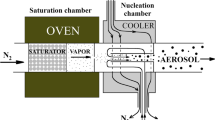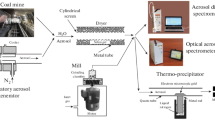Abstract
The mechanism of formation of nanosized aerosol particles during mechanical grinding of coal from Kuzbass mines is studied. The concentration and size spectrum of aerosol particles in a mine tunnel during cutter operation were measured using an aerosol spectrometer. It is found that 90% of the particles are less than 200 nm in size. In the nanometer range, there are two peaks corresponding to average diameters of 20 and 150 nm, the first of which is due to single particles, and the second to aggregates consisting of single particles. The formation of aerosol during mechanical coal grinding in a continuous flow mill was studied. The spectrum and morphology of the particles produced in the laboratory mill are in qualitative agreement with those for the nanoaerosol formed in the mine. The influence of the coal aerosol on the combustion of gas mixtures was studied. Laboratory experiments showed that the presence of the nanoaerosol in a lean methane–air mixture significantly increased its explosibility. This was manifested in an increase in the maximum pressure and a significant increase in the pressure rise rate during explosion. The study leads to the conclusion that the nanoaerosol is formed from the organic coal components released into the gas phase during local heating of coal on the cutter teeth.
Similar content being viewed by others
References
K. A. Lebetski and S. B. Romanchenko, Dust Explosion Hazard of Mining (Promtshlennaya Bezopasnost, Moscow, 2012), Vol. 6 [in Russian].
V. C. Marshall, Major Chemical Hazards (John Wiley, New York, 1987).
Analysis of Explosion Containment Systems in Coal Mines and Evaluation of Their Performance: Research Report of the Interdepartmental Commission on Explosives (Academy of Mining Sciences, Moscow, 2014) [in Russian].
G.-D. Gong, C.-H. Bai, and Q.-M. Liu, “Study on Explosion Process of Methane-Coal Dust Mixture,” J. Coal Sci. Eng. 19 (3), 332–336 (2013).
A. D. Gillies and S. Jackson, “Some Investigations into the Explosibility of Mine Dust Laden Atmospheres,” Coal Operators Conf. Wollongong, 626–640 (1998).
C. Bai, G. Gong, Q. Liu, Y. Chen, and G. Niu, “The Explosion Overpressure Field and Flame Propagation of Methane–Air and Methane–Coal Dust/Air Mixtures,” Saf. Sci. 49, 1349–1354 (2011).
Q. Liu, C. Bai, X. Li, L. Jiang, and W. Dai, “Coal Dust/Air Explosions in a Large-Scale tube,” Fuel 89, 329–335 (2010).
Q. Liu, Y. Hu, C. Bai, and M. Chen, “Methane/Coal Dust/Air Explosions and Their Suppression by Solid Particle Suppressing Agents in a Large-Scale Experimental Tube,” J. Loss Prevent. Process Ind. 26, 310–316 (2013).
S. R. Rockwell and A. S. Rangwala, “Influence of Coal Dust on Premixed Turbulent Methane–Air Flames,” Combust. Flame 160, 635–640 (2013).
A.M. Baklanov, S. V. Valiulin, S. N. Dubtsov, V.V. Zamashchikov, V. I. Klishin, A. E. Kontororvich, A. A. Korzhavin, A. A. Onischuk, D. Yu. Paleev, and P. A. Purtov, “Nanoaerosol Fraction in Industrial Coal Dust and Its Effect on the Explosibility of Coal Dust–Methane–Air Mixtures,” Dokl. Akad. Nauk 461 (3), 295–299 (2015).
A. Ankilov, A. Baklanov, R. Mavliev, S. Eremenko, G. P. Reichel, and A. Majerowicz, “Comparison of the Novosibirsk Automated Diffusion Battery with the Vienna Electron Mobility Spectrometer,” J. Aerosol Sci. 22 (Suppl. 1), S325–S328 (1991).
P. A. Mavliev, A. N. Ankilov, A. M. Baklanov, A. M. Gorbunov, N. A. Kakutkina, K. P. Kutsenogii, S. E. Pashchenko, and V. I. Makarov, “Using a Screen-Type Diffusion Battery to Determine the Aerosol Dispersion,” Kolloid. Zh. 46 (6), 1136–1141 (1984).
R. A. Mavliev and A. N. Ankilov, “Methods of Processing Data for a Screen-Type Diffusion Battery,” Colloid. Zh. 47 (3), 523–530 (1985).
N. A. Fuks, Mechanics of Aerosols (Izd. Akad. Nauk SSSR, Moscow, 1955) [in Russian].
Y. S. Cheng, H. C. Yeh, and K. J. Brinsko, “Use ofWire Screens as a Fan Model Filter,” Aerosol Sci. Technol. 4 (2), 165–174 (1985).
Aerosol Measurement: Principles, Techniques, and Applications, Ed. by P. A. Baron and K. Willeke (Wiley Interscience, New York, 2001).
D. Gonzalez, A. G. Nasibulin, A. M. Baklanov, S. D. Shandakov, D. P. Brown, P. Queipo, and E. I. Kauppinen, “A New Thermophoretic Precipitator for Collection of Nanometer-Sized Aerosol Particles,” Aerosol Sci. Technol. 39, 1064–1071 (2005).
W. C. Hinds, Aerosol Technology. Properties, Behavior, and Measurement of Airborne Particles (Wiley Interscience, New York, 1999).
P. C. Reist, Aerosol Science and Technology (McGraw-Hill, New York, 1993).
V. V. Rashevskii, V. B. Artem’ev, and S. A. Silyutin, Quality of SUEK Coals (Kuchkovo Pole, Moscow, 2010).
S. K. Friedlander, Smoke, Dust, and Haze (Oxford Univ. Press, New York–Oxford, 2000).
N. A. Fuks and A. G. Sutugin, Highly Dispersed Aerosols (VINITI, Moscow, 1969) [in Russian].
R. J. Samson, G. W. Mulholland, and J. W. Gentry, “Structural Analysis of Soot Agglomerates,” Langmuir. 3, 272–281 (1987).
S. N. Rogak, U. Baltensperger, and R. C. Flagan, “Measurement of Mass Transfer to Agglomerate Aerosols,” Aerosol Sci. Technol. 14, 447–458 (1991).
V. V. Karasev, A. A. Onischuk, O. G. Glotov, A. M. Baklanov, A. G. Maryasov, V. E. Zarko, V. N. Panfilov, A. I. Levykin, and K. K. Sabelfeld, “Formation of Charged Aggregates of Al2O3 Nanoparticles by Combustion of Aluminum Droplets in Air,” Combust. Flame 138, 40–54 (2004).
A. A. Onischuk, S. di Stasio, V. V. Karasev, et al., “Evolution of Structure and Charge of Soot Aggregates During and After Formation in a Propane/Air Diffusion Flame,” Aerosol Sci. 34, 383–403 (2003).
A. A. Onischuk, V. P. Strunin, V. V. Karasev, and V. N. Panfilov, “Formation of Electrical Dipoles During Agglomeration of Uncharged Particles of Hydrogenated Silicon,” Aerosol Sci. 32, 87–105 (2001).
M. Katzer, A. P. Weber, abd G. Kasper, “Collision Kinetics and Electrostatic Dispersion of Airborne Submicrometer Fractal Agglomerates,” J. Colloid and Interface Sci. 240, 67–77 (2001).
H. D. Jang and S. K. Friedlander, “Restructuring of Chain Aggregates of Titania Nanoparticles in the Gas Phase,” Aerosol Sci. Technol. 29 81–91 (1998).
Physical Quantities, Ed. by I.S. Grigor’ev andE.Z.Meilikhov (Energoizdat, Moscow, 1991) [in Russian].
Author information
Authors and Affiliations
Corresponding author
Additional information
Original Russian Text © S.V. Valiulin, A.M. Baklanov, S.N. Dubtsov, V.V. Zamaschikov, V.I. Klishin, A.E. Kontorovich, A.A. Korzhavin, A.A. Onischuk, D.Yu. Paleev, P.A. Purtov, L.V. Kuibida.
Published in Fizika Goreniya i Vzryva, Vol. 52, No. 4, pp. 36–50, July–August, 2016.
Rights and permissions
About this article
Cite this article
Valiulin, S.V., Baklanov, A.M., Dubtsov, S.N. et al. Influence of the nanoaerosol fraction of industrial coal dust on the combustion of methane–air mixtures. Combust Explos Shock Waves 52, 405–417 (2016). https://doi.org/10.1134/S0010508216040043
Received:
Published:
Issue Date:
DOI: https://doi.org/10.1134/S0010508216040043




